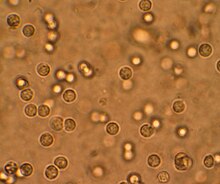
Back بيلة قيحية Arabic Piúria Catalan Pyurie German Piuria Spanish Piuria Basque پیوری Persian Pyurie French פיאוריה HE Piuria ID Piuria Italian
| Pyuria | |
|---|---|
 | |
| White blood cells seen under a microscope from a urine sample. | |
| Pronunciation | |
| Specialty | Urology |
Pyuria is the condition of urine containing white blood cells or pus. Defined as the presence of 6-10 or more neutrophils per high power field of unspun, voided mid-stream urine, it can be a sign of a bacterial urinary tract infection. Pyuria may be present in people with sepsis, or in older people with pneumonia. Others additionally require discoloration, clouding or change in the smell of urine for a pyuria to be present. Without these additional features, there is said to be leukocyturia.
Sterile pyuria[1] is urine which contains white blood cells while appearing sterile by standard culturing techniques. It is often caused by sexually transmitted infections, such as gonorrhea, or viruses which will not grow in bacterial cultures. Sterile pyuria is listed as a side effect from some medications such as paracetamol (acetaminophen). Its occurrence is also associated with certain disease processes, such as Kawasaki disease and genitourinary tuberculosis.[2] However, there are many known causes, including systemic or infectious disease, structural and physiological reasons, intrinsic kidney pathology, or drugs.[2]
- ^ Gilbert J. Wise & Peter N. Schlegel (March 12, 2015). "Sterile Pyuria". N Engl J Med. 372 (11): 1048–1054. doi:10.1056/NEJMra1410052. PMID 25760357.
- ^ a b Dieter RS (2000). "Sterile pyuria: a differential diagnosis". Compr Ther. 26 (3): 150–2. doi:10.1007/s12019-000-0001-1. PMID 10984817. S2CID 11629600.
© MMXXIII Rich X Search. We shall prevail. All rights reserved. Rich X Search